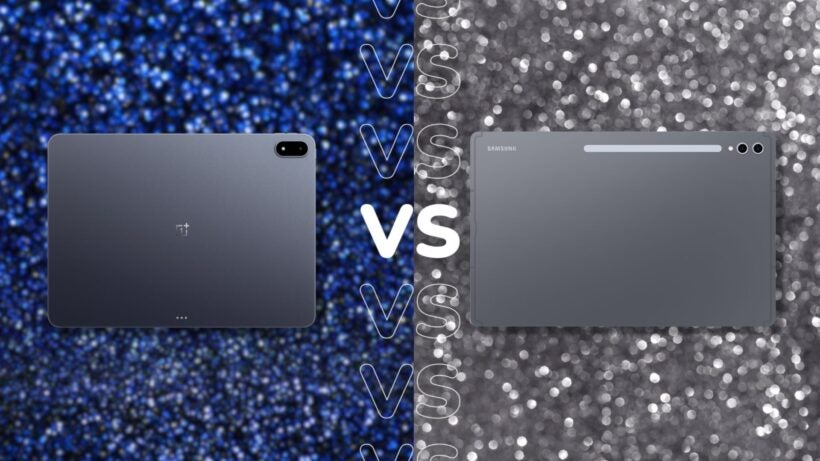
The OnePlus Pad 3 is a mid-range tablet with a flagship spec sheet – but how does it compare to the top-end Samsung Galaxy Tab S10 Ultra?
The OnePlus Pad 3 and Samsung Galaxy Tab S10 Ultra target very different corners of the Android tablet market. One is a highly capable all-around that redefines what a £529/$699 device can offer, while the other is a big-screen productivity and media powerhouse that costs more than double.
However, the specs rarely tell the whole story, and for a lot of people, the OnePlus Pad 3 could be the better tablet. Here’s how the two compare based on our real-world experience.
Price and availability
The OnePlus Pad 3 is the more affordable of the two by some margin, coming in at a rather affordable £529 in the UK and $699 in the US. It’s available to pre-order now, with release set for 20 June in the UK and 7 July in the US.
The Samsung Galaxy Tab S10 Ultra, on the other hand, is Samsung’s top-end tablet with a price tag to match, starting at £1,199/$1,199. Like the Pad 3, it’s also available to buy right now, following its release back in October 2024.
Design
There’s no getting around the frankly huge dimensions of the Tab S10 Ultra. Sporting a 14.6-inch screen and weighing in just over 700g, it’s more of a laptop replacement than a casual tablet.
That said, Samsung has done an impressive job with its design; it’s an impressively thin 5.4mm thick and sports stronger Enhanced Armour Aluminium to make it feel tougher without the added bulk, while the IP68 water and dust resistance is a rare and welcome addition.

You also get Samsung’s excellent S Pen bundled in, though its magnetic rear-mounted storage remains a minor frustration – it doesn’t sit flush on a table when connected, and it’s easily dislodged in a rucksack.
The OnePlus Pad 3 sports a smaller – but still sizeable – 13.2-inch screen, making it the more manageable of the two tablets. Its sub-6mm thickness and lighter weight make it easier to hold one-handed or carry around in a bag than Samsung’s alternative.
The new flat-edge design and blue matte aluminium finish make it look every bit the premium product, and we remain impressed by how refined it feels, even when compared to pricier rivals like Samsung’s top-end Tab.

That said, the OnePlus Pad 3 doesn’t come with a stylus in the box, nor is there any water or dust resistance on offer. If those things matter to you, the Tab S10 Ultra could be the tablet to go for – though the Pad 3 remains the more portable of the two.
Winner: Samsung Galaxy Tab S10 Ultra
Screen
If there’s one reason to choose the Tab S10 Ultra over not only the Pad 3 but practically every Android tablet on the market, it’d be the screen. The 14.6-inch Dynamic AMOLED 2X is a showstopper of a screen; it’s huge, vibrant and immersive with slim bezels.

As a result, it’s great for everything from streaming on Netflix to multitasking with DeX, and the anti-reflective coating, lifted from the Galaxy S24 Ultra, does a remarkable job of reducing reflections and improving usability outdoors. With a 16:10 aspect ratio and an LTPO-enabled 120Hz refresh rate, it’s both well-suited to movies and surprisingly battery-efficient.
The OnePlus Pad 3 can’t quite match the vivid colours and deep blacks of AMOLED tech, but its LCD display is no slouch. At 13.2 inches with 12-bit colour, Dolby Vision and a fast 144Hz refresh rate, it delivers stunning clarity and smoothness. And, as a plus, its pixel-packed 3.4K resolution bests the 1.8K offering from the Tab S10 Ultra.

The unique 7:5 aspect ratio also makes it more practical for work and split-screen multitasking than Samsung’s alternative, especially when paired with the optional Keyboard Case.
While the black levels and contrast naturally lag behind Samsung’s AMOLED panel, and it misses out on LPTO tech, the Pad 3’s screen is still one of the best in its class – and much more than you’d expect at its mid-range price point.
Winner: Samsung Galaxy Tab S10 Ultra
Cameras
Let’s be honest, nobody buys a tablet for the camera tech; it’s a nice-to-have but definitely not a dealbreaker. That is, unless, you’re one of those people who take concert photos on an iPad. That said, of the two tablets, the Tab S10 Ultra is the more versatile.

The Tab S10 Ultra sports a 13MP main and 8MP ultrawide on the rear, alongside dual 12MP wide and ultrawide selfie cameras on the front, housed within a notch. The latter are particularly handy for video calls, especially when multiple people are squeezing into the call, or if you’re presenting something.

The Pad 3, in comparison, keeps it fairly simple with the same 13MP rear and 8MP front snappers found on the OnePlus Pad 2. It’s a fine combination for basic tasks like document scanning and video calling, but it doesn’t exactly stand out – though neither tablets will replace your phone cameras anytime soon.
Winner: Samsung Galaxy Tab S10 Ultra
Performance
Even though the Samsung Galaxy Tab S10 Ultra costs nearly double that of the OnePlus Pad 3, it’s the latter tablet that’s more powerful.

That’s down to the Pad 3’s inclusion of the Snapdragon 8 Elite, Qualcomm’s top-end chipset for 2025, along with a healthy 16GB of RAM. As a result, the OnePlus Pad 3 isn’t just faster than the Galaxy Tab S10 Ultra, but it outpaces some models of iPad – and that’s not something we’ve seen from any Android tablet until now.
As you might imagine, that translates to impressive everyday performance, with the Pad 3 able to handle everything we could throw at it – from high-end 3D games to heavy multitasking – while staying cool to the touch. That’s an astonishing achievement for an Android tablet, especially one with a mid-range price tag.

The Galaxy Tab S10 Ultra’s combination of MediaTek’s Dimensity 9400+ and 16GB of RAM mean it’s similarly capable at handling demanding tasks like high-end gaming in real-world use. However, it falls short of the OnePlus Pad 3’s performance in most benchmark tests – and by quite a way at times.
Winner: OnePlus Pad 3
Software
The Tab S10 Ultra makes the most of its size with Samsung’s OneUI 6 – though it recently got the upgrade to OneUI 7 and its refreshed UI. Still, the core featureset remains; the full Galaxy AI suite, complete with features like AI photo editing, live transcription and image generation, as well as support for Circle to Search and Samsung’s excellent DeX system.
The latter is particularly useful for desktop-style work, providing a UI closer to that of Windows than an Android tablet, though you’ll need a fairly expensive keyboard case to make the most of the system.

Samsung also offers an impressive seven years of OS upgrades and security patches for the tablet, one of the best you’ll find on any Android tablet.
The Pad 3, on the other hand, runs OxygenOS 15, and offers one of the best tablet-focused software experiences around.
That starts with its Open Canvas multitasking software, which remains one of the best implementations on Android. The ability to run and rearrange up to three apps with saved layouts makes it feel more like a laptop than most tablets in its price range.

Then there are elements like O+ Connect to consider, with the ability to access your Mac desktop remotely with keyboard and trackpad control. It’ll even play nicely with iOS devices, allowing you to share photos, videos and other files between the two systems – though the iOS device will need the O+ Connect app for it to work.
It also ties in nicely with the Keyboard Cover and its built-in NFC tag, allowing you to tap your OnePlus phone to share internet connectivity, files or your entire screen, depending on what you’re doing.
Essentially, OnePlus offers a more tablet-focused experience than the Tab S10 Ultra, with more unique features on offer. It doesn’t go all-in on AI like Samsung, and it only offers three OS upgrades, but the core experience is fast, clean and practical.
Winner: OnePlus Pad 3
Battery Life
Samsung’s 11,200mAh battery provides solid endurance considering the sheer size of its screen and the performance on offer. In testing, it comfortably lasted a couple of days with mixed use, though standby power consumption was a little high for our liking.

It’s also quite slow to charge with 45W charging, clocking 50% in little over an hour, with a full charge approaching the two-hour mark.
The OnePlus Pad 3 not only lasts longer with a larger 12,140mAh battery, but it also charges faster. We finished a full work day with 30% left in the tank on one day of testing, with enough juice left to power an evening of use. Standby time is also impressive, draining less than 20% over the course of five days.

The 80W SuperVOOC charging is the icing on the cake, though you’ll need to source a SuperVOOC-branded charger to take advantage – one doesn’t come in the box.
That said, even with a regular high-wattage charger, you’ll see a full charge in around 90 minutes. That’s much faster than Samsung’s effort despite having the larger battery of the two, and it’s well ahead of much of the tablet competition.
Winner: OnePlus Pad 3
Final Thoughts
The Galaxy Tab S10 Ultra is undoubtedly Samsung’s best Android tablet to date – it’s massive, powerful and packed full of features. It’s made for creatives, remote workers and media lovers who want the best screen and flexibility. However, at £1,199/$1,199, it’s a premium product that’s not for everyone. You’re paying for size, DeX and a premium ecosystem.
The OnePlus Pad 3, on the other hand, delivers shockingly good performance, display quality and battery life for half the price. It might lack some polish around AI, and you don’t get a bundled stylus, but it’s arguably the best Android tablet in its price range – and a better pick for most users who want power, portability and value in one neat package.
Unless you specifically want a 14-inch canvas and Samsung’s software tricks, the OnePlus Pad 3 is the smarter buy in 2025.



